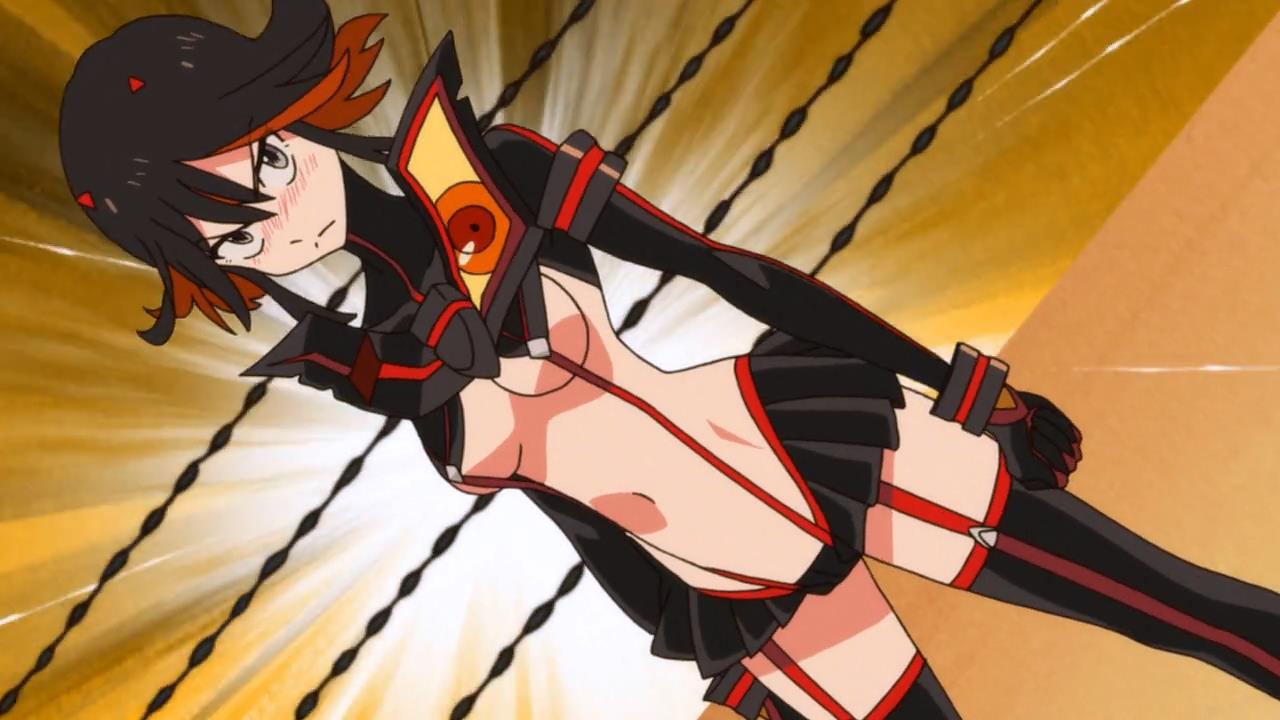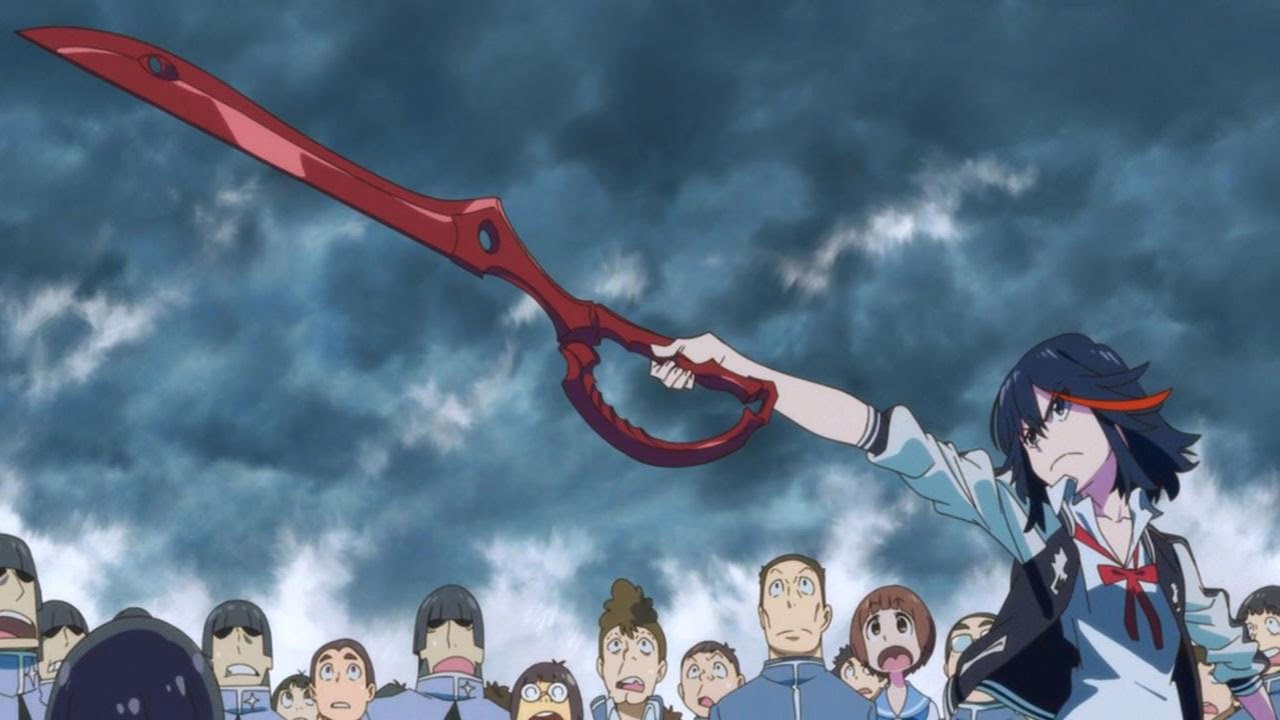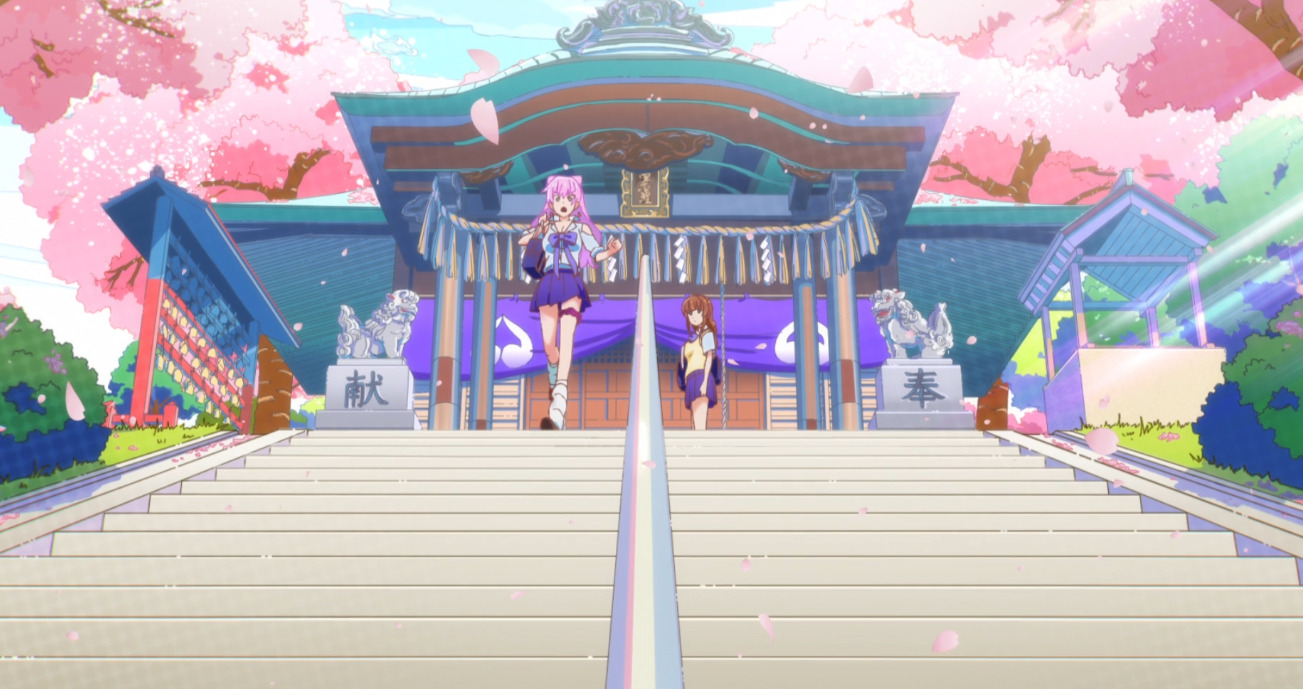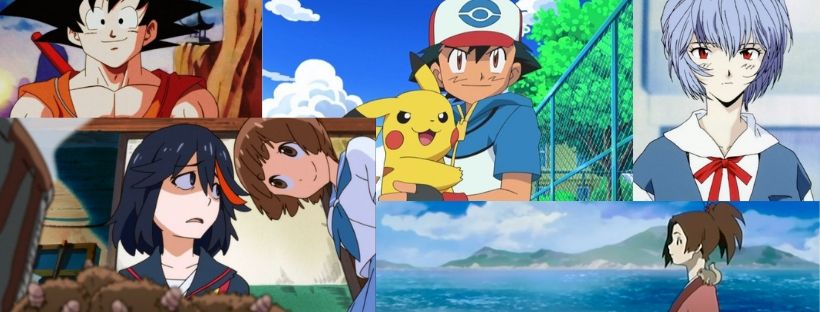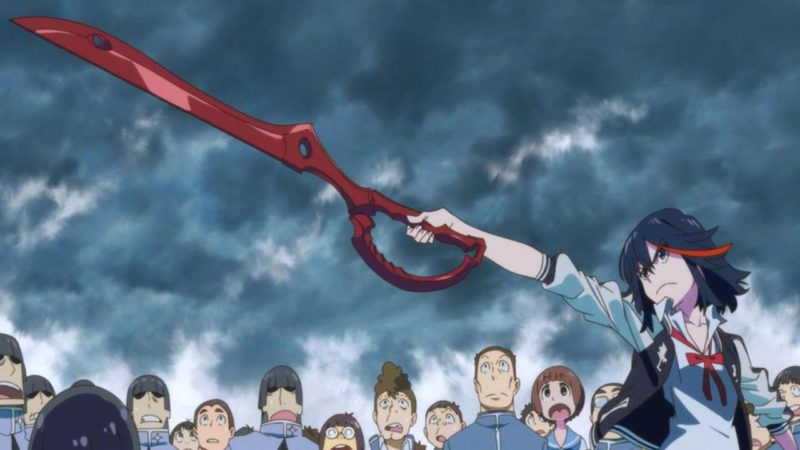
Kill la Kill subverts many of anime’s most common tropes. It takes the tournament story format, stuffs it into high school, makes fan service a major story element, twists the magical girl plot with a revenge plot, and crams all of this into a science-fiction story that features the Joseph Campbell’s Hero’s Journey template. Warning: I will spoil this wild ride.
Armed with a single-bladed scissor-sword given to her by her dying father, Ryuko Matoi arrives at Honno City with only one goal: to avenge the murder of her father. Her search leads her toward the one person who may know who killed her father, the student president of Honnounji Academy, Satsuki Kiryuin. Honnounji Academy is a high school that rules over the surrounding area with Satsuki standing at the top of the hierarchy. The rank of students with the academy determines the welfare of their families. Student rank is determined by martial ability and divides the student body into no-stars, single-stars, two-stars, and the elite three-stars. The three-stars are known as the Elite Four and dominate the school on Satsuki’s behest. The academy’s uniforms, called Goku Uniforms (nice Dragon Ball reference!), which are made of special fibers called Life Fibers. Life Fibers enhance a student’s abilities, allowing them to transform their appearance when entering combat. Think magical-girl transformations but for everyone with a uniform, not just the female cast. As revealed later in the story, Life Fibers are a parasitic alien life form that stimulates and feeds off the energy of the human nervous system. Life Fibers spurred human evolution by becoming clothing and encouraging humans to wear them. Life Fibers will kill most humans if they enter the human’s body, so laying on the skin becomes the only solution for Life Fibers to thrive.
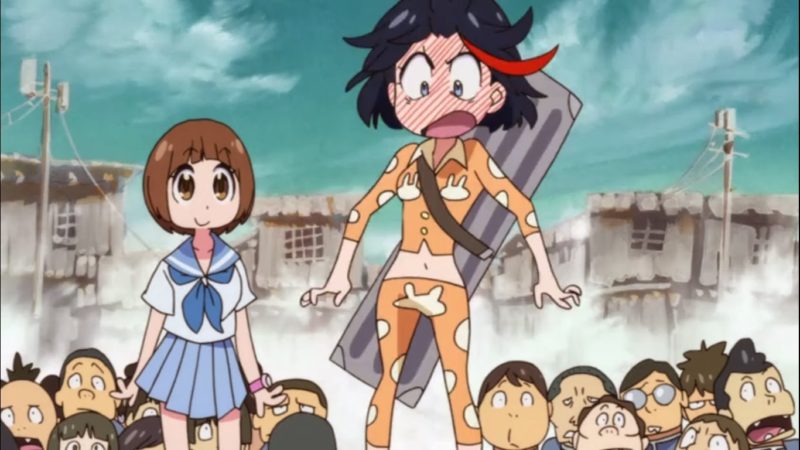
In typical tournament format, Ryuko begins to work through the ranks of the academy by defeating club-leaders, who are 2-stars, and working her way up to face against the Elite Four during a battle royal Satsuki orders. The Naturals Election, as Satsuki names the tournament, seeks to reorder the academy and weed out the weakest students. The tournament is interrupted by Nui Harime, the chief tailor of the REVOCS Corporation. REVOCS is ran by Satsuki’s mother Ragyo Kiryuin. Nui confronts Ryuko and pulls out the opposite blade of Ryuko’s scissors. Nui then reveals herself to be the murderer of Ryuko’s father. Ryuko’s rage overwhelms her reason and Senketsu, and their roles reverse. Ryuko becomes clothing for Senketsu, turning them into a vengeful, out-of-control amalgamation. Only after Mako intervenes can Ryuko regain control. These events pivot the story away from the tournament structure.
Satsuki follows her mother’s orders and uses the Goku Uniform-enhanced students to conquer other schools in an effort to suss out an organization called Nudist Beach. Nudist Beach is an organization created by Ryuko’s father with the goal of resisting the plans of REVOCS. Ragyo acts as the agent of the Life Fibers with the goal of clothing the entire planet in Life Fibers. Once this is done, the Life Fibers will drain the planet and cause it to burst, seeding Life Fibers across space. Life Fibers work like Lavos if you’ve played Chrono Trigger. Ragyo was using Satsuki as a part of her plans, but Satsuki had plans of her own. She uses Honnounji Academy to build an army of Life Fiber resistant students to stop her mother’s plans. During a school festival held in her mother’s honor, Satsuki launches her attack. But Ragyo reveals she’s a Life Fiber human hybrid and not so easily killed. She also reveals she ordered Nui to kill Ryuko’s father, her own husband. Turns out Ragyo is also Ryuko’s mother! Ryuko was used in Life Fiber experiments as a newborn, which transformed her into a Life Fiber human hybrid. Ryuko learns through Nudist Beach that Senketsu is a mirror of her. Her father used her DNA to make Senketsu.
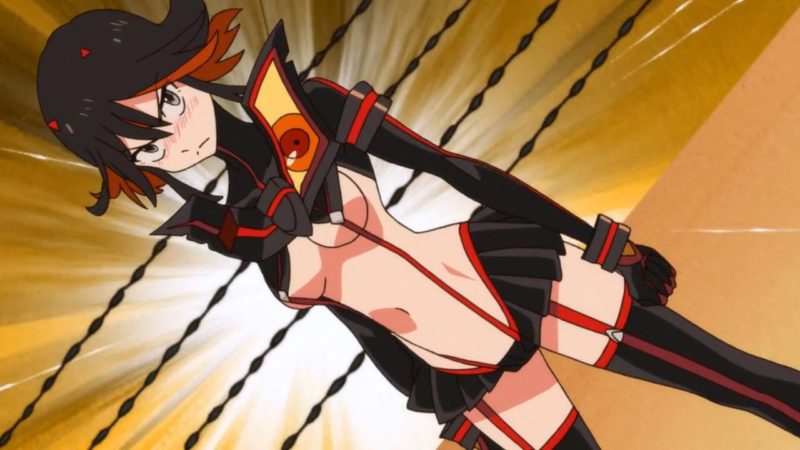
Ryuko goes into a coma after the shock of learning that she isn’t human and having Ragyo tear our her Life Fiber-woven heart. When Ryuko awakes, she turns her back on her friends and on Senketsu in the belief that she was a monster. She goes to face Ragyo alone, but Ragyo and Nui capture her and stitch Junketsu to her. The process brainwashes the already emotionally vulnerable Ryuko into fighting against Satsuki and her friends. Ryuko is eventually knocked back to her senses and joins with the remnants of Nudist Beach and Honnounji Academy for the final battle.
Ragyo had planned on using the transmitter at Honnounji Academy to broadcast her control over the Life Fibers and so clothe the planet using humanity. Satsuki, Ryuko, and the rest of the gang fight and foil this plan, forcing Ragyo to her B plan. During the fight, Ryuko manages to get both blades of the scissors her father had made. Plan B has Ragyo don Nui’s Life Fiber masterpiece, Shinra-Koketsu, which allows Ragyo to control Life Fibers directly, making her a new Primordial Life Fiber, the core of the alien parasites. Ragyo is again thwarted, so she falls back to Plan C. She orders Nui to kill herself. This allows Nui to become one with the Primordial Life Fiber. Nui had been created by Ragyo and can be considered a half-sister to Ryuko and Satsuki. Nui’s suicide allows Ragyo to succeed in clothing the planet in Life Fibers. But before this cloth closes, Ryuko and Satsuki’s friends offer up their Goku Uniforms to power Senketsu to carry Ryuko up to confront her mother alone. Ryuko and Senketsu thwart Ragyo by using Senketsu’s ability to absorb Life Fibers. Senketsu absorbs Ragyo’s ability to control Life Fibers, and Ryuko orders the Life Fibers to free everyone. Severed from their energy source and the Primordial Life Fiber, they all dissipate. Ryuko tells her mother that they are going to go back together, but Ragyo won’t have any of that. She pulls out her own heart and destroys it. She then dissipates. Senketsu, however, cannot control the amount of power he had absorbed from Ragyo. With the last of his will, he takes Ryuko back to the planet. The heat of reentry is too much for him, and so he burns to nothing as he protects Ryuko one last time. The credits roll with Mako, Ryuko and Satsuki on a much-needed date.
The Hero’s Journey Template
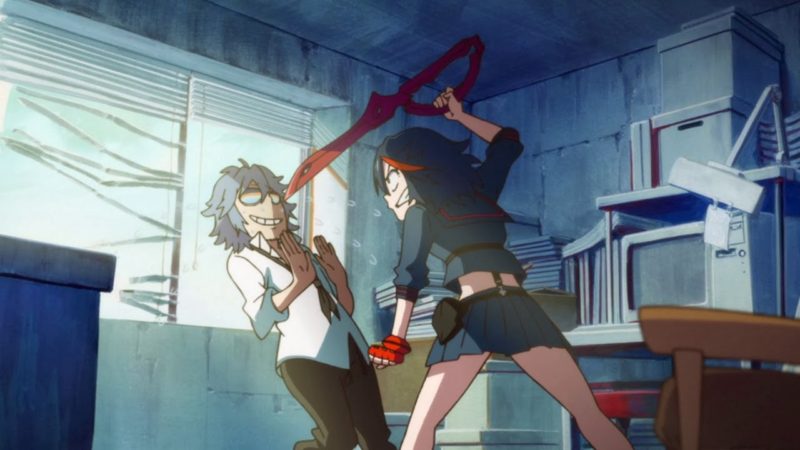
- Call to Adventure – the initial call to begin the journey. Ryuko is called to adventure when she finds her dying father and receives half of the scissor blade.
- The Helper – the hero comes across a supernatural helper which aids them on their adventure. Ryuko finds Senketsu.
- The Threshold – also known as “the door of no return”, this marks the point where the hero cannot turn back. This step includes the various sections of the adventure:
- Brother-battle – the hero battles with their brother. In this case, Ryuko fights against Satsuke, her sister. She also faces Nui, her half-sister.
- Dragon-battle, the hero fights a dragon that will either grant a charm or kill the hero in some way. Ryuko fights against Ragyo and is “killed” (enters a coma) by learning the reality of her existence.
- Dismemberment / Crucifixion – the hero returns from the world of the dead with new knowledge and/or after sacrificing themselves. Ryuko “dies,” represented by the coma she enters, after her encounter with her mother. Most mythological heroes must fight against their fathers as a part of their growth as a hero. They must overcome their fathers to be recognized by them. Campbell calls this “father atonement.” In Ryuko’s case, we have the feminine version of this theme. She must overcome her mother.
- Abduction – the hero is taken in by the enemy and plunged toward the “dark night of the soul.” Ryuko is taken by her mother and stitched into Junketsu.
- The Night-Sea Journey – the hero needs to work through the dark night of the soul and come to accept themselves. This part of the template begins at the “dismemberment” phrase for Ryuko and comes to a head when she fights against her friends while stitched in Junketsu.
- Wonder Journey – the hero gains a supernatural ability which allows them to confront their final trial. Ryuko regains her connection with Senketsu and using the Goku Uniform Life Threads of her friends, flies off the planet to confront her mother.
- Whale’s Belly – the hero hits another low point during the final confrontation. In this case, Ragyo manages to clothe the planet in Life Fibers.
- Sacred Marriage – the hero merges with the sacred female which allows him to become a whole person. Ryuko rejoins with Senketsu, creating an inverse of the male hero merging with the sacred female pattern (Senketsu is male), and achieves this oneness during their final battle with Ragyo, allowing Senketsu to absorb Ragyo’s powers.
- Father Atonement – the hero’s father recognizes the hero. Ragyo recognizes Ryuko as her daughter after their final battle and just before Ragyu rejects the outcome by killing herself.
- Apotheosis – the hero realizes his divinity. Ryuko realizes her own divinity while she fights with her mother the final time. This allows her to fight without regard for her own well-being.
- Elixir Theft – the hero finds the boon which he brings back to restore the world. Ryuko and Senketsu’s ability to absorb Life Fibers acts as a boon which restores the world after its been clothed by Life Fibers.
- Return / Rescue – the hero returns to the normal world. The return usually involves a price to the hero. The rescue phase usually involves the helper acting in some way to help the hero. In Ryuko’s case, Senketsu gives his life to see her safely returned.
- Resurrection – the hero returns a different person. This is shown during the credit roll: Ryuko is a stronger person with an appreciation for what Senketsu did for her.
- Threshold Struggle – the hero struggles with returning to normal life. Ryuko misses Senketsu and must now navigate her new relationship with her sister.
The Hero’s Journey template can be shuffled based on the story. Kill la Kill shifts the steps a bit and combines a few, but it maps well to the template. The mythic story-telling template Campbell outlines sits behind the oldest stories we have and behind modern stories like Kill la Kill. The template provides flexibility. While mythic heroes are men who seek recognition and seek to surpass their fathers, Kill la Kill takes this theme and has Ryuko and Satsuki aim to be recognized and to surpass their mother. While the story is primarily an action-comedy, it has many layers of depth. It satirizes various anime tropes, comments on our relationship with clothing and nudity, discusses body perception, comments on anime fan service, and takes the traditionally masculine Hero’s Journey and maps it to female heroines. There’s a lot going on! Add in stellar action-animation that plays with emotiveness and stylization and sharp-dialogue, and Kill la Kill has the potential to stand alongside long-time greats like Cowboy Bebop. Interestingly, Kill la Kill isn’t much discussed in the anime community despite its sophistication once you get beyond its surface. While the story does a lot of different things, it hasn’t subverted or upended any genres like Neon Genesis Evangelion did. The story isn’t really a magical-girl story. It has elements of it. The story isn’t really a tournament fighting story. It has elements of it. What makes the story strong also weakens it because Kill la Kill doesn’t belong in any one genre. It isn’t grounded enough to act as a pivot for a genre. It remains, however, an important work because of the commentary it provides for anime and the feminine conversion of the Hero’s Journey it presents.
Of course, in the end, Kill la Kill is also a fun time. It has likable characters, strong female leads, zaniness thanks to the members of Nudist Beach, a hinted romance story between Mako and Elite Four member Ira Gamagori, and universal sex appeal. It’s entertaining for those who just want to relax while still providing narrative layers for those who like to dissect stories. Kill la Kill remains one of Trigger’s triumphs.
